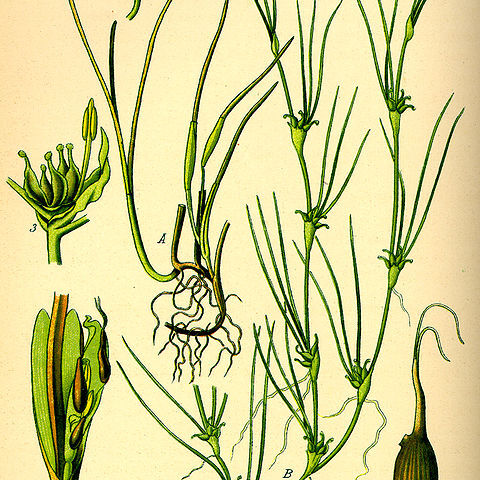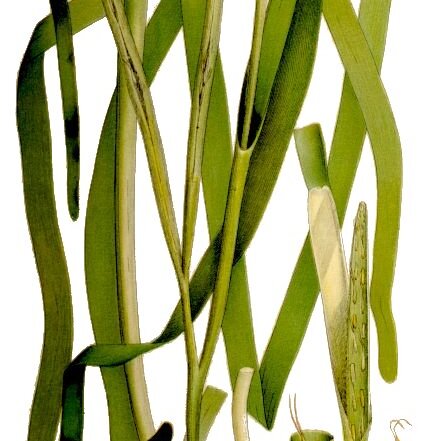Perennial herbs adapted to life in shallow sea water, with creeping rhizomes, monoecious or dioecious; rhizomes creeping or tuberous, nodes with intervaginal scales. Leaves distichous, linear or filiform; leaf sheath open or closed, often with stipuloid flanges, with an auriculate ligule at the junction with the blade; blade parallel-veined, sometimes with midrib. Inflorescence of 1 to several spadices, each enclosed in a spathe formed by the sheath of the next leaf; flowers small, sessile in two rows on a flattened axis; pollination by water; petals absent, stamen 1, sessile, dorsifixed, anther with longitudinal slits, the pollen filamentous, without exine, with the same density as sea water; pistillate flower protogynous, gynoecium 1, 1-locular with basally united styles and two stigmatic arms; ovule single, pendulous, orthotropous, bitegmic. Fruit a small irregular drupe, or irregularly dehiscing; endosperm absent
Herbs, perennial, rarely annual, rhizomatous, caulescent; turions absent. Leaves alternate, submersed, sessile; sheath persisting longer than blade or decaying with age into bundles of woolly fibers, not leaving circular scar when shed, not ligulate, auriculate with scarious lobes; blade linear; intravaginal squamules scales, more than 2. Inflorescences axillary or terminal, spadices, surrounded by spathe, pedunculate; peduncle following fertilization not elongating, not spiraling. Flowers unisexual, staminate and pistillate on same plant or different plants; subtending bracts (retinacula) often present; perianth absent. Staminate flowers: stamens 1; anthers dehiscing longitudinally; pollen linear. Pistillate flowers: pistils1, not stipitate; ovules pendulous, orthotropous. Fruits achenelike. Seeds 1; embryo straight.
Herbs, perennial, rarely annual, in saline water, rhizomatous, caulescent. Leaves alternate, submersed, sessile, sheath persisting longer than blade or decaying into bundles of fibers, blade linear. Inflorescences axillary or terminal, spadices surrounded by spathe, pedunculate. Plants monoecious or dioecious; flowers unisexual; subtending bracts often present; perianth lacking. Male flowers with single stamen, anthers dehiscing longitudinally. Female flowers with single pistil. Fruit achenelike. Seed 1 with straight embryo.


